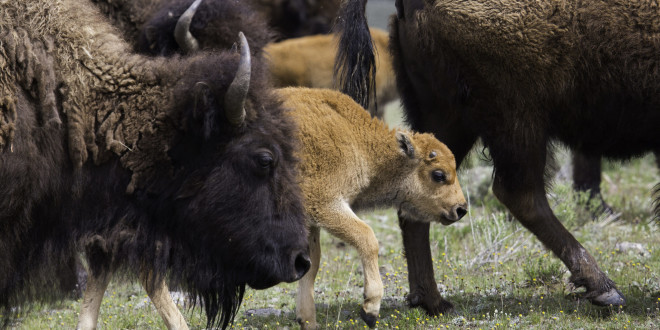Yellowstone National Park officials have proposed culling around 1,000 bison this winter—mostly calves and females—to curb migration into Montana.
This is, of course, par the course for winter. The state of Montana and the federal government agreed to annual bison culling in 2000, in an effort to prevent possible transmission of brucellosis between bison and livestock and keep the herd’s population at a “manageable” level.
Officials will meet with representative from American Indian tribes, as well as state and federal agencies. Hunters are projected to take down 300 or more this winter, while others will be captured and slaughtered for research. The season started Monday, November 15.
The current Yellowstone bison herd clocks in at around 5,000. Harsh winter weather could drive many into southwestern Montana if the Park is unable to support them. From the Bozeman Daily Chronicle:
“Through the legal agreement the National Park Service has to do this,” said Yellowstone spokeswoman Sandy Snell-Dobert. “If there was more tolerance north of the park in Montana for wildlife, particularly bison as well as other wildlife, to travel outside the park boundaries, it wouldn’t be an issue.”
Yellowstone has one of the largest wild bison herds remaining in the world. Since the 1980s, more than 6,300 have been slaughtered and almost 1,900 killed by hunters.
Despite that aggressive effort, the park’s herds remain at near-record levels. Last winter, officials removed 737 of the animals, falling short of their target of up to 900 animals.
This year’s proposal puts more emphasis on killing females and calves, to reduce the population’s reproductive rate.
“They are a hardy species,” said Stephanie Adams with the National Parks Conservation Association. “But until there’s more room for bison to range beyond the park boundary, we’re going to have to rely on larger numbers of bison being sent to slaughter.”
The Yellowstone bison herd is cherished as a conservation success story, as the species was brought back from the brink of extinction just over a century before. Further, Yellowstone bison are one of the few wild populations left.
Finding compromise on Yellowstone bison has been nothing short of difficult, if not impossible, for the time being. Efforts to expand bison range back into historic reaches have been met with opposition time and time again, not only from ranchers concerned with brucellosis and competition for grazing, but also from landowners and people concerned for public safety. According to the Chronicle, Montana Governor Steve Bullock has proposed letting bison roam year-round west of Yellowstone—but only if the population dips below 3,500.
On the other side of the coin, advocates for free-ranging bison have started voicing their opinion more. Tribal representatives, meanwhile, have started asking for bison, to preserve a part of their ancestry.
2015 brought an interesting wrinkle to the future of Yellowstone bison. Earlier this November, ten “genetically pure” bison were released onto Soapstone Prairie Natural Area and Larimer County’s Red Mountain Open Space. These bison were not only direct descendants of the Yellowstone herd; they were also brucellosis-free, due to genetic work through Colorado State University.
If the Soapstone herd proves viable, perhaps more brucellosis-free, Yellowstone-line bison herds could be established across the West.
UPDATE: Park officials have scrapped this number. Read here to learn why.
 Yellowstone Insider Your Complete Guide to America's First National Park
Yellowstone Insider Your Complete Guide to America's First National Park





